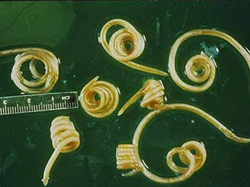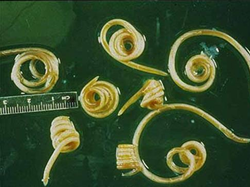[ad_1]

Roundworms (toxocara canis) are the most common intestinal parasite in pets.
It’s our hope that the new CAPC Top 10 Cities Monthly ROUNDWORM Report will prompt important conversations between pet owners and their veterinarians about roundworm protection.
SALEM, Ore. (PRWEB)
November 10, 2020
The Companion Animal Parasite Council (CAPC) — the nation’s leading source on parasitic diseases that threaten the health of pets and people — today issued the CAPC Top 10 Cities Monthly ROUNDWORM Report for the past month — with Charleston, West Virginia, topping the list at #1 across the country.
The new monthly report alerts pet parents, veterinarians and pet-related services about the threat of roundworm infection — a zoonotic, parasitic disease threatening the health of both pets and people. The report identifies U.S. metro areas experiencing the highest percentage increase in positive roundworm tests in the last 30 days.
“The recent outbreak of COVID-19, with its animal origin, has made people acutely aware of the close relationship between animal and human health — and the need to regularly monitor disease at the local level,” said Dr. Chris Carpenter, DVM and CAPC’s Chief Executive Officer. “With the ever-present threat of roundworm infections – particularly during fall and winter months – CAPC expands its decade-long mission to regularly monitor parasitic diseases in communities across the U.S. with its new CAPC Top 10 Cities Monthly ROUNDWORM Report.”
Roundworm can be lethal, particularly for puppies and kittens. In national data collected October 1 – 31, 2020, these 10 U.S. cities had the highest percentage increase in positive roundworm tests:
1) Charleston, West Virginia
2) Mobile, Alabama
3) Wichita, Kansas
4) Killeen, Texas
5) Little Rock, Arkansas
6) Miami, Florida
7) Memphis, Tennessee
8) Alexandria, Virginia
9) Winston-Salem, North Carolina
10) Visalia, California
“An increase in roundworm prevalence not only alerts communities to a persistent threat to the health of dogs and cats, but it also warns of a significant threat to the health of children and families who can potentially contract roundworm infection,” said Dr. Craig Prior, BVSC, CVJ, CAPC board member.
Surveys of fecal samples from across the U.S. show that more than 30 percent of dogs younger than 6 months of age are shedding Toxocara canis (roundworm) eggs — with CAPC parasite prevalence maps reporting positive cases of roundworm infection in both dogs and cats in all 50 states. Due to the high prevalence of roundworm, it can be assumed that virtually every puppy or kitten is infected at or soon after birth.
“This demonstrates how vital it is for dogs and cats to be protected against roundworm parasites with broad-spectrum, year-round preventatives, and at a minimum, bi-annual testing,” Prior added. “By protecting your pet, you are protecting other pets, your family, other families — and your entire community.”
WHAT ARE ROUNDWORMS?
Roundworms (toxocara canis) are the most common intestinal parasite in pets. Dogs and cats can become infected through ingestion of roundworm eggs in the environment or from eating infected hosts such as rodents or birds. Infected dogs and cats then shed the microscopic roundworm eggs back into the environment in their feces, compounding the cycle of infection.
- Symptoms of roundworm infection include weight loss, diarrhea, vomiting, dull coat, and/or a pot-bellied appearance. Severe infections can result in death.
- Prevalence of roundworm infection is higher in fall and winter months. Because roundworm eggs have a strong protective layer, they are not sensitive to extreme temperatures and can survive in the environment for months — and even years.
- Roundworm infection is most severe in puppies and kittens. The disease can be transmitted directly from the mother to puppies and kittens from nursing worm larvae from the mother’s milk. Puppies may be infected with roundworm from the time they are born because the mother can pass roundworm to the puppy through the placenta (this is not the case with kittens.)
Can humans be harmed by roundworm?
Roundworms pose a significant risk to humans — and are most common in children. People can be infected from handling and accidentally ingesting dirt containing roundworm larva that can migrate to the liver, lungs, muscle and brain. Children are more likely to be infected after playing in contaminated soil. Clinical symptoms vary but are often characterized by fever, malaise, cough and abdominal pain. Severe infections may cause respiratory failure or blindness.
RISK FACTORS FOR ROUNDWORM EXPOSURE
Pets living in cities on this month’s CAPC Top 10 Cities Monthly ROUNDWORM Report may have been exposed due to several risk factors:
- Any outdoor area where dogs and cats have access can become reservoirs for roundworm. Typical areas of contamination include neighborhood streets and common areas, gardens, parks, playgrounds, sandboxes, beaches, rest areas — and your own backyard. It’s also critical to regularly clean pet’s indoor living areas —including bedding, bowls, balls and other toys — and clean cat litter boxes daily.
- Prompt removal of pet feces is critical to preventing the spread of roundworm. In communities across the country, dog owners not picking up their dog’s stool is a contentious issue — and for good reason. According to the U.S. Environmental Protection Agency, 40% of dog owners don’t pick up dog stool. “Dog owners need to be diligent in immediately removing fecal waste in public areas — and at least once a week in their own backyards,” Prior said. “It’s more than a cosmetic issue. Pet owners who are irresponsible in picking up after their dogs are putting the health of their own dog, other dogs — and the health of everyone in their community at risk
- Dog parks are quickly becoming a standard feature in many communities. A recent study by The Trust for Public Land reported 744 off-leash dog parks in the top 100 cities in the U.S. in 2018 — a 40% increase since 2009. And studies reveal that 27% of fecal samples collected in dog parks contained GI parasites (roundworm, hookworm or whipworm). “The popularity of dog parks is a major factor in the persistent number of roundworm infections. Unlike boarding or day care facilities, dog parks don’t require proof of immunization and parasite protection,” Prior said. “And while dog parks provide a unique opportunity for dogs to exercise, it’s not uncommon for dog owners to socialize, and while not paying close attention — even for a few minutes — their dog defecates, leaving stool behind as a potential source of infection.”
- Compliance in testing and protecting pets. CAPC recommends puppies and kittens be tested at least four times in the first year of life for roundworm and other intestinal parasites; and at least two times every year in adults. CAPC also recommends that all dogs and cats be protected with monthly broad-spectrum parasite control with efficacy against roundworm year-round. To pinpoint risk for roundworm, CAPC parasite prevalence maps provide roundworm prevalence in every U.S. county.
“For nearly a decade, CAPC has been a national leader in monitoring parasitic diseases that threaten pets and people with timely, local disease prevalence maps,” Carpenter said. “It’s our hope that the new CAPC Top 10 Cities Monthly ROUNDWORM Report will prompt important conversations between pet owners and their veterinarians about roundworm protection.”
ABOUT CAPC
The Companion Animal Parasite Council (http://www.capcvet.org) is an independent not-for-profit foundation comprised of parasitologists, veterinarians, medical, public health and other professionals that provides information for the optimal control of internal and external parasites that threaten the health of pets and people. Formed in 2002, CAPC works to help veterinary professionals and pet owners develop the best practices in parasite management that protect pets from parasitic infections and reduce the risk of zoonotic parasite transmission.
Share article on social media or email:
[ad_2]

